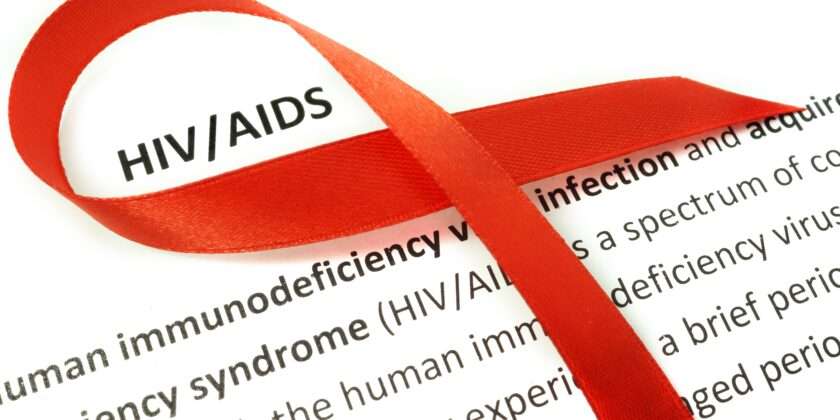HIV stands for human immunodeficiency virus. If left untreated, HIV can lead to the disease AIDS (acquired immunodeficiency syndrome).
Unlike some other viruses, the human body can’t get rid of HIV completely. So once you have HIV, you have it for life1 .
HIV is one of the most important health issues facing the Black American community today. The facts about HIV among African Americans today are terrible.
Nearly 20 years of HIV destroying the community!
Now the facts from the Office of Minority Health2 (OMH):
Although African Americans represent 13% of the U.S. population, they account for 43% of HIV infection cases in 2014.
- African American males have 8 times the AIDS rate as white males.
- African American females have 22 times the AIDS rate as white females.
- African American men are almost 7 times as likely to die from HIV/AIDS as non-Hispanic white men.
- African American women are 14 times as likely to die from HIV/AIDS as non-Hispanic white women.
- In 2014, African Americans were 8.1 times more likely to be diagnosed with HIV infection, as compared to the white population.[releatedposts]
Jay Harold worked as an Infectious Disease Pharmacist in the mid-1990’s and watched the transition from a White Male disease to a Black Male disease.
- In 1998, the U.S. Centers for Disease Control and Prevention (CDC) reported that African Americans account for 49% of U.S. AIDS-related deaths. AIDS-related mortality for African Americans is almost 10 times that of Whites and three times that of Hispanics3 .
The current data makes you wonder if any progress has been made over the last twenty years.
What’s the Good News?
Sharing needles, syringes, and other injection equipment puts people who inject drugs (PWID) at high risk for getting HIV and other infections, including hepatitis. Annual HIV diagnoses among black and Hispanic/Latino PWID were cut in half between 2008–2014, but diagnoses among white PWID dropped by only 28%4 . This is very good news from the CDC!
One reason may be that fewer blacks and Hispanics/Latinos are sharing needles and syringes, while whites are more likely to share them. Syringe services programs (SSPs) can play a role in preventing HIV and other health problems among PWID. They provide access to sterile syringes and should also provide comprehensive services such as help with stopping substance misuse; testing and linkage to treatment for HIV, hepatitis B, and hepatitis C; education on what to do for an overdose; and other prevention services. State and local health departments can work with their lawmakers and law enforcement to make SSPs more available to PWID.

African American males have 8 times the AIDS rate as white males.
This is the one situation where being selfish paid off for Black people.
HIV diagnoses among PWID have decreased, but progress has been uneven.
The number of PWID getting HIV has been cut in half in the U.S.
- Annual HIV diagnoses among PWID decreased by 48% overall (2008–2014).
- Annual HIV diagnoses fell by about 50% among black and Hispanic/Latino PWID, both in urban and nonurban areas (2008–2014).
- Annual HIV diagnoses dropped by 28% among urban white PWID during 2008–2012 but did not decrease from 2012–2014. Trends among nonurban whites were similar.
There have been changes in who is starting to inject drugs.*
- In 2005, blacks and whites each made up 38% of new PWID (those who have been injecting for 5 years or less).
- In 2015, blacks made up 19% of new PWID and whites made up 54%.
- The percent of new PWID who are Hispanic/Latino stayed around the same at about 21%.
Some PWID are at higher risk for getting HIV from sharing syringes.*
- About 46% of new white PWID shared syringes, compared with 32% of Hispanics/Latinos and 28% of blacks.
- White PWID started injecting at younger ages than other races/ethnicities, and younger people were more likely to share syringes.
- Syringe sharing was low (13%) among PWID who got all their syringes from sterile sources like SSPs, but high (41%) among those who didn’t.
*In 22 cities with a high number of HIV cases
Reality Check for Minorities
The following resources are useful tools and should be utilized. The new administration of Donald Trump may significantly reduce the funding of some of these programs. For example, the repeal of Obamacare5 is a top priority of Donald Trump, and its replacement details are unknown.
What Can Be Done
The Federal government is
- Allowing certain state and local prevention programs to use their federal funds for SSPs (not to buy needles, syringes, and other injection equipment). For more information, visit http://bit.ly/2eVU8ab. Pages 7 to 16 is where you find the lists of state and local programs.
- Providing support and access to HIV, hepatitis, and substance use disorder prevention and treatment, including medication-assisted treatment and mental health services.
- Providing guidelines to healthcare providers for appropriate prescribing practices to reduce opioid abuse and overdoses.
- Monitoring national trends for HIV, hepatitis, and drug overdoses.
State and local health departments can
- Use data on HIV, hepatitis, substance use, and overdoses to determine where services are needed.
- Work with law enforcement and local leaders to expand access to SSPs, where permitted by law.
- Provide HIV and hepatitis testing and prevention services for PWID.
- Ensure treatment is available for overdoses, HIV, hepatitis, and substance use disorder, and inform first responders about available resources.

In 2015, blacks made up 19% of new PWID and whites made up 54%.
Healthcare providers can
- Screen patients for substance use disorder, including the misuse of prescription opioids. Provide or link PWID to medication-assisted treatment, and link them to mental health services, if needed.
- Test PWID for HIV and hepatitis and treat them if they are infected. Vaccinate patients for hepatitis A and B, if appropriate.
- Prescribe sterile syringes to PWID, or refer them to SSPs or pharmacies that provide sterile syringes, where permitted by law.
- Provide or refer PWID to HIV risk reduction counseling.
Lawmakers, judges, police and other criminal justice officials can
- Address legal and law enforcement barriers that prevent or discourage the use of SSPs and substance use disorder treatment, including the use of medication-assisted treatment.
- Refer PWID to substance use disorder treatment and HIV and hepatitis prevention services.
- Support HIV and hepatitis testing and care and hepatitis vaccination in prisons and jails.
This is where voting in local and state elections is the key to ensuring adequate funding for these services.
People who inject drugs can
- Get help to stop injecting drugs. SAMHSA.gov, or 1-800-662-HELP (4357).
- Use only new, sterile syringes, safely dispose of used syringes, and never share any equipment if injecting drugs. Contact the local health department or NASEN.org to find an SSP.
- Get tested for HIV and hepatitis C at least once a year. Get vaccinated for hepatitis A and B if not infected. People who have HIV or hepatitis should get medical care and take medicines as prescribed.
Jay Harold has written several posts of HIV/AIDS including:
Federal Dollars for HIV/AIDS: More $$$$
HIV: 5 Facts Black People Should Know!
Enjoyed this post? Share it and read more here. Questions? “Ask the Pharmacist a Question!”
Please take this advice of Muhammad Ali and give back to others. “Service to others is the rent you pay for your room here on earth.” ~ Muhammad Ali
Jay Harold is always looking out for your health and wealth.
Bibliography
- https://www.aids.gov/hiv-aids-basics/hiv-aids-101/what-is-hiv-aids/
- https://minorityhealth.hhs.gov/omh/browse.aspx?lvl=4&lvlid=21
- https://www.aids.gov/hiv-aids-basics/hiv-aids-101/aids-timeline/
- https://www.cdc.gov/vitalsigns/hiv-drug-use/index.html
- http://thehill.com/policy/healthcare/312640-trump-plans-executive-actions-for-obamacare-repeal




